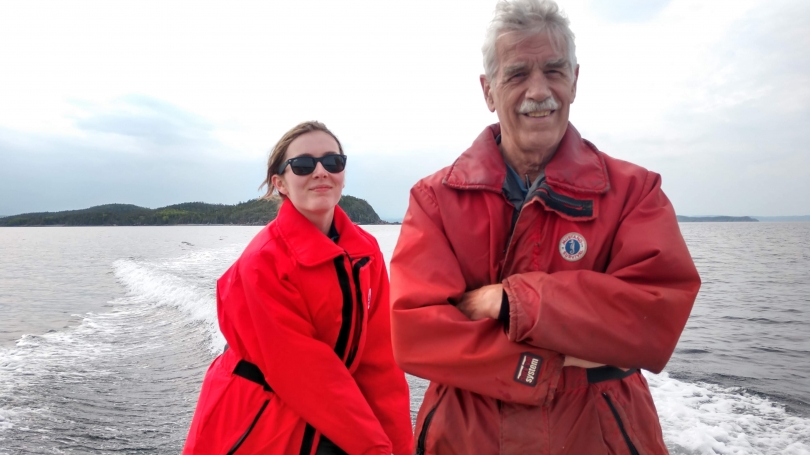
Menu
- About
- Programs
- Student Opportunities
- For Faculty
- News & Events
Back to Top Nav
Back to Top Nav
Back to Top Nav
Back to Top Nav
Back to Top Nav
By Ava Hill '22
When I signed up to boat around northern Canada to do archaeology for nearly two months, I had no idea what I was getting myself into. I imagined a picturesque, adventure-filled summer, like something out of a Wes Anderson movie. Turns out that, visually, I wasn't far off. The colorful houses and boats of coastal northern canada, along with the icebergs and arctic birds, made for great cinematography. As we drove up towards Lushes Bight, Newfoundland, where our boat the Pitsuilak was docked, I felt romanticization of the region creeping in. Even now, the beauty of the physical landscape makes it hard not to look back on the trip without rose-colored glasses. I soon saw that northern Canada is so much more than the postcards, although itinerant icebergs, whales, and puffins were abundant.
We spent a few days in Lushes Bight, Long Island, where I learned, despite their heavy accents, about the Newfoundlanders' unique culture, from mummers to ugly sticks. Soon the boat was ready to depart for the northern tip Newfoundland (Quirpon). It was a beautiful day on Long Island when we left, but the next two days on the seas were rough, which was an abrupt initiation into the maritime world. Luckily I wasn't seasick, so it felt like an eight-hour rollercoaster ride. On land at Quirpon, it still felt like the ground was moving. The next few days were spent ashore due to bad weather, and we spent one visiting the first UNESCO World Heritage Site L'Anse aux Meadows, where Leif Eriksson and a group of Norsemen briefly settled. Once the weather cleared, we sailed across the Strait of Belle Isle to Brador, Quebec, just south of the Labrador border. After a bug-filled day of preparing the Hart Chalet site for excavation upon our return, we sailed south. The next week was spent surveying around northern Quebec, looking for potential Inuit sites. We went as far south as Mutton Bay and La Tabatière before returning north to Brador. Our surveying didn't reveal anything too significant, just some cache pits and a tent ring, but it was still a really amazing experience to explore the area by boat.
The next week we excavated the artifact-rich Hart Chalet site at Brador. I was so excited when I found a nail within the first hour of digging for the first time, but that soon faded away as I found nail after nail after nail. It was still exciting to find other things, though, such as a long white glass bead which could be used to date the site. The week went by quickly: wake up, eat, dig, eat, dig, eat, socialize with the crew, go to sleep, repeat. July 29th quickly arrived and we rendezvoused with a group of divers from the University of Montréal. We sailed down to St. Paul with them, and for the next two weeks we excavated an Inuit site at Grand Isle while they searched for traces of Basque sites underwater. A highlight of Grand Isle was being able to snack on ripe orange arctic berries called bakeapples (or cloudberries) as we walked to and from the site. We also saw a screening of the Canadian documentary A Place of Tide and Time in St. Paul, where it was filmed. The documentary captured what it felt like to be there, and it was enlightening to see the Lower North Shore from the filmmakers' broad perspective. We ended our time in St. Paul with a presentation at the local Whitely museum, where we presented our findings. One exciting thing the divers found was a potential new Basque site, which would be the southernmost one yet.
The trip came to an abrupt end. Within hours, it was decided that we would end a few days early due to beat the bad weather on the trip back to Newfoundland. I had grown accustomed to bumping my head when I tried to sit up in bed, eating mostly bread and vegetables, not having phone service, and spending evenings playing card games and signing Beatles songs with the crew. It was strange to come back to warm weather and the ability to Google things. I was sad to be leaving the crew, many of whom I had forged lasting friendships with, although we still had a long drive back to Hanover with everyone before the summer felt truly over. It was definitely a summer I will never forget.
Ava performed archaeological and environmental fieldwork in Newfoundland, Labrador, and eastern Quebec with the Smithsonian Arctic Studies Center in July and August 2019. Her experience was funded by an Institute of Arctic Studies Stefansson Fellowship.